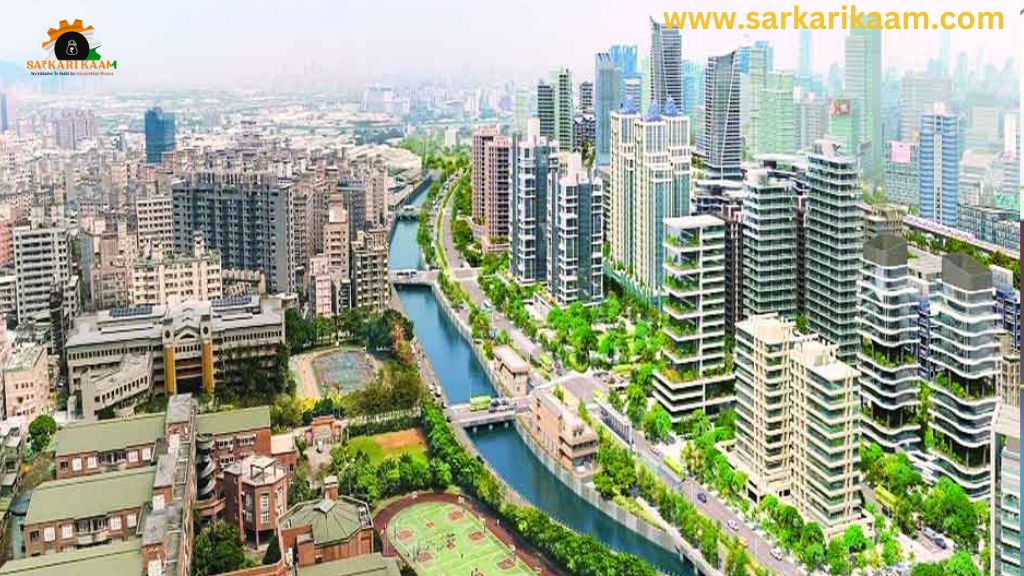
India is on the cusp of an industrial revolution. The government’s ambitious National Industrial Corridor Development Programme (NICDP) is set to transform the country’s economic landscape through the development of 12 innovative industrial smart cities.
With a massive investment of ₹28,602 crore, these cities are not just urban projects—they are dynamic hubs of industry, innovation, and sustainable growth that promise to fuel regional development, attract global investments, and generate millions of jobs. This is a turning point that redefines how India will build its future.
A Vision for Transformation
The NICDP represents more than a collection of new urban centers—it embodies a visionary strategy for creating world-class manufacturing ecosystems. Strategically located along the Golden Quadrilateral (connecting Delhi, Mumbai, Kolkata, and Chennai), these industrial smart cities will combine advanced infrastructure with global best practices. The goal is to lower logistical costs, increase GDP, and foster a competitive environment that elevates India’s role in the global supply chain.
Key Investments and Strategic Locations
- Comprehensive Infrastructure: The NICDP is focused on creating state-of-the-art industrial hubs with plug-and-play utilities, smart ICT-enabled environments, and reliable power and water supply.
- Sustainable Development: Projects within these smart cities incorporate green practices like advanced power grids, sustainable water management, zero wastewater discharge systems, and renewable energy integration. This ensures that development is environmentally sustainable.
- Enhanced Connectivity: Situated along the major transport corridors of India, these smart cities benefit from seamless connectivity. Highways, dedicated freight corridors, rail networks, ports, and airports work in unison to create cost-effective and efficient supply chains.
Industry-Specific Growth and Innovation
The NICDP aims to revolutionize multiple sectors by creating specialized industrial zones tailored to specific industries:
Automotive and Engineering Hubs
- Khurpia Industrial Park (Uttarakhand): With an investment of ₹6,180 crore, this park will focus on automobile manufacturing, engineering, and fabrication. It aims to become a center for technological innovation and mass production.
Electronics and Technology Zones
- Rajpura Industrial Park (Punjab): Targeting electronics, textiles, and fabricated metal production, this park is expected to foster high-tech manufacturing capabilities with an investment potential of ₹7,500 crore.
Emerging Sectors
- Agriculture, EVs, and Apparel: In locations such as Prayagraj and Agra in Uttar Pradesh, and in Gaya, Bihar, specialized industrial parks are being developed. They will focus on electric vehicles, textile manufacturing, cycle production, and agricultural goods, thereby diversifying India’s industrial base.
Port-Linked Industrial Areas
- Dighi Port Industrial Area (Maharashtra): Spanning 6,056 acres, this project aims to employ over 114,000 people across engineering, pharmaceuticals, and chemical industries. Its proximity to port facilities will significantly reduce logistics costs.
Specialized Regional Projects
- Zaheerabad Project (Telangana): Covering 3,245 acres, this hub is tailored for the production of transportation and electrical equipment, along with both metallic and non-metallic resources.
- Palakkad Industrial Park (Kerala): With a focus on medicinal and botanical products, high-tech industries, and fabricated metal products, this park represents Kerala’s foray into high-value manufacturing.
Economic Impact and Job Creation
The NICDP is expected to reshape the industrial landscape of India dramatically. These industrial smart cities are forecast to attract investments worth a staggering ₹1.52 lakh crore. This influx of capital will lead to:
- Robust GDP Growth: By lowering logistical costs and integrating advanced manufacturing technology, these hubs will contribute substantially to national GDP growth.
- Massive Employment Opportunities: The projects are projected to generate approximately one million direct jobs and an additional three million indirect jobs, transforming the employment landscape in the regions where they are established.
- Strengthened Supply Chains: The development of such industrial clusters is set to enhance the overall competitiveness of India’s manufacturing sector in global markets.
Supporting Policies and Business-Friendly Environment
The successful implementation of the NICDP is bolstered by a range of government initiatives designed to ease business operations and promote industrial growth. The PM Gati Shakti initiative—focusing on last-mile connectivity, expedited land acquisition, and minimal ecological impact—ensures that these smart cities are developed with efficiency and sustainability in mind. Furthermore, the adoption of a “single-window” clearance system reduces bureaucratic hurdles, enabling businesses to set up operations faster and with greater ease.
These measures, coupled with the government’s commitment to ease-of-doing-business, create an environment where global investors find India exceptionally attractive. The strategic focus on sustainable, technologically advanced industrial parks is key to India’s ambition of becoming a global manufacturing hub.
Challenges and the Road Ahead
Despite the promising outlook, the NICDP faces its own set of challenges:
- Regulatory and Infrastructure Hurdles: Ensuring smooth coordination between state governments and private stakeholders is critical to overcoming delays in project execution.
- Balancing Development and Sustainability: Industrial expansion must be managed carefully to minimize environmental impact while promoting economic growth.
- Global Competition: As India competes with other emerging economies, it will need to continuously innovate and optimize its industrial policies to maintain its competitive edge.
Nevertheless, the strategic planning and robust support from both government and the private sector signal a bright future. With targeted reforms, dedicated investment, and a focus on sustainability, India is well-positioned to address these challenges and continue its rapid industrial transformation.
Shaping a Resilient Economic Future
The National Industrial Corridor Development Programme is more than an infrastructure project; it is a bold vision for the future. By creating a network of smart, sustainable industrial hubs along the Golden Quadrilateral, India is redefining how industrial growth can drive overall economic development. These smart cities are not only set to boost manufacturing but will also create livable urban environments that prioritize a “walk-to-work” culture and comprehensive social infrastructure.
As these cities come to life, they will pave the way for regional development, reduced logistical costs, and enhanced global competitiveness. Ultimately, the NICDP embodies India’s commitment to fostering innovation, ensuring sustainable growth, and building a resilient future—one smart city at a time.


